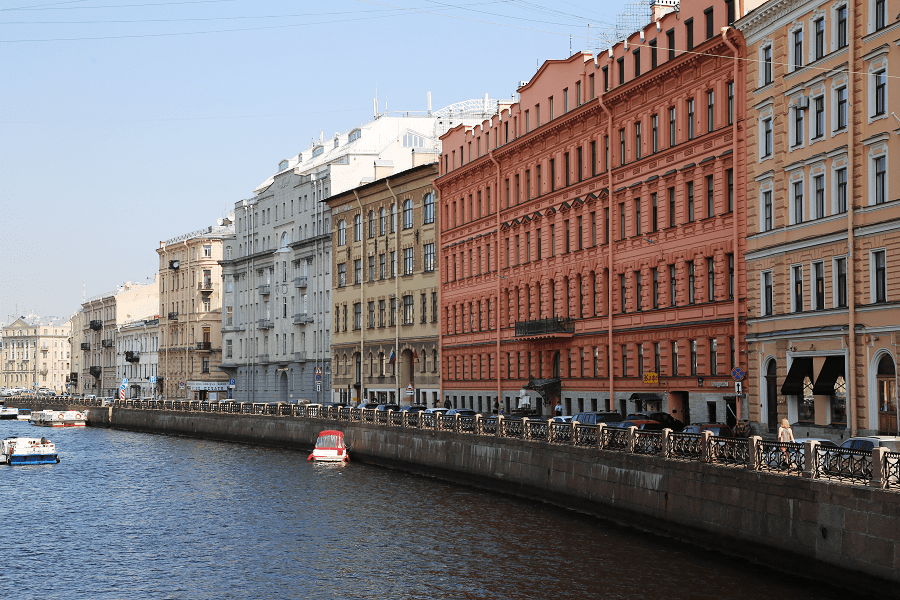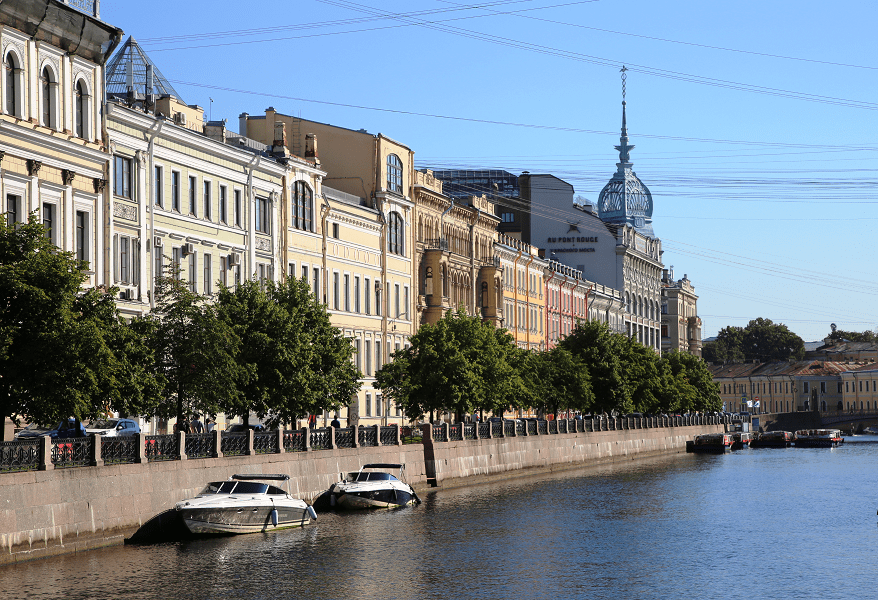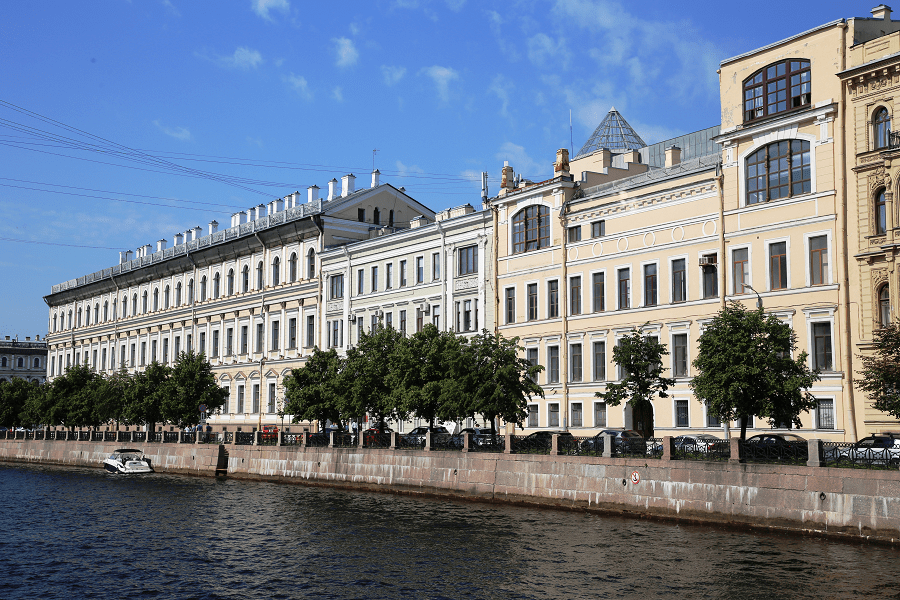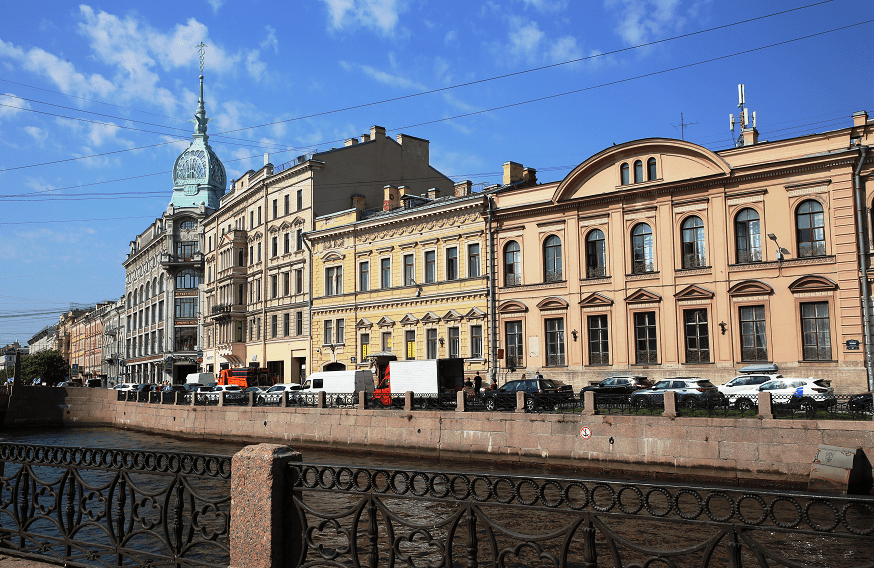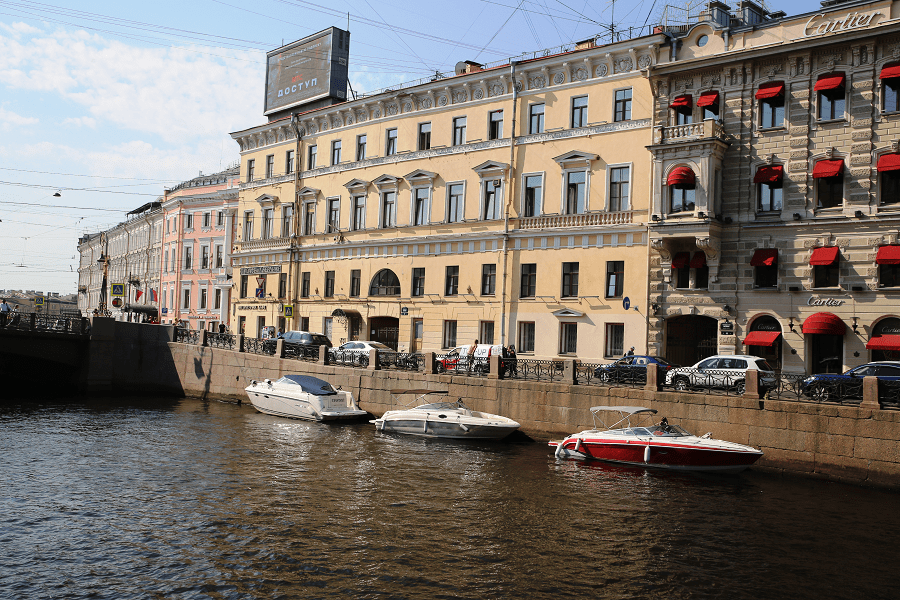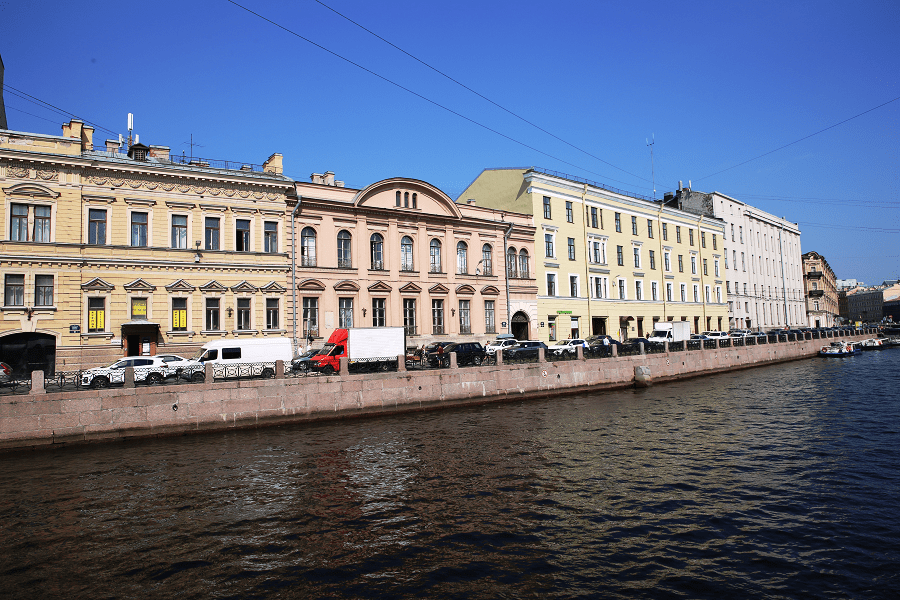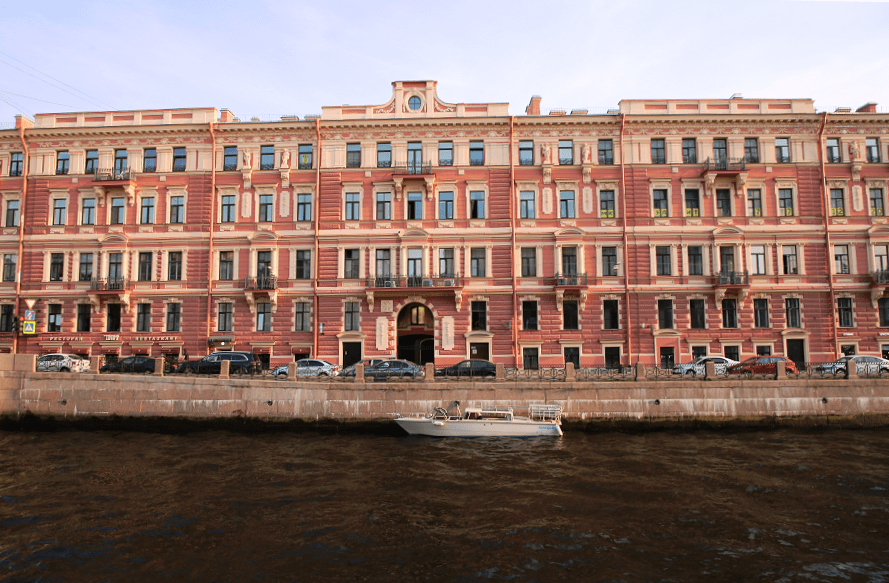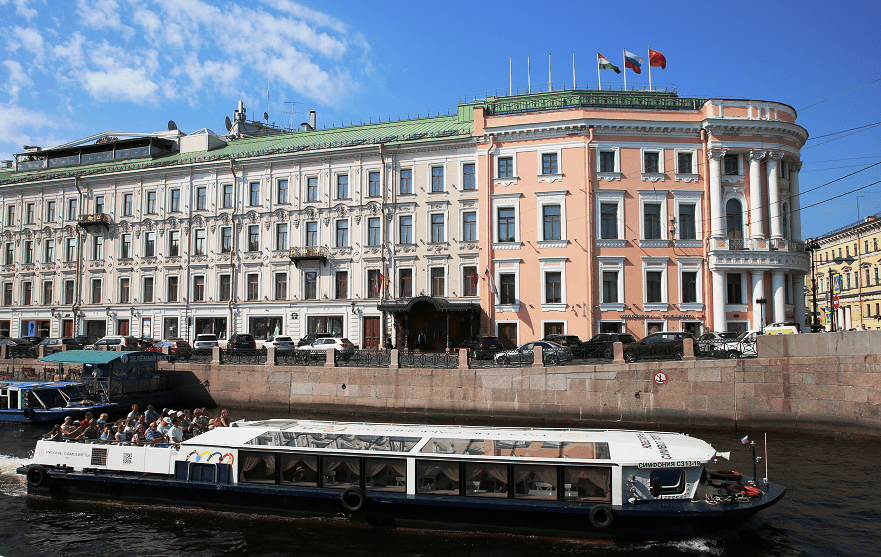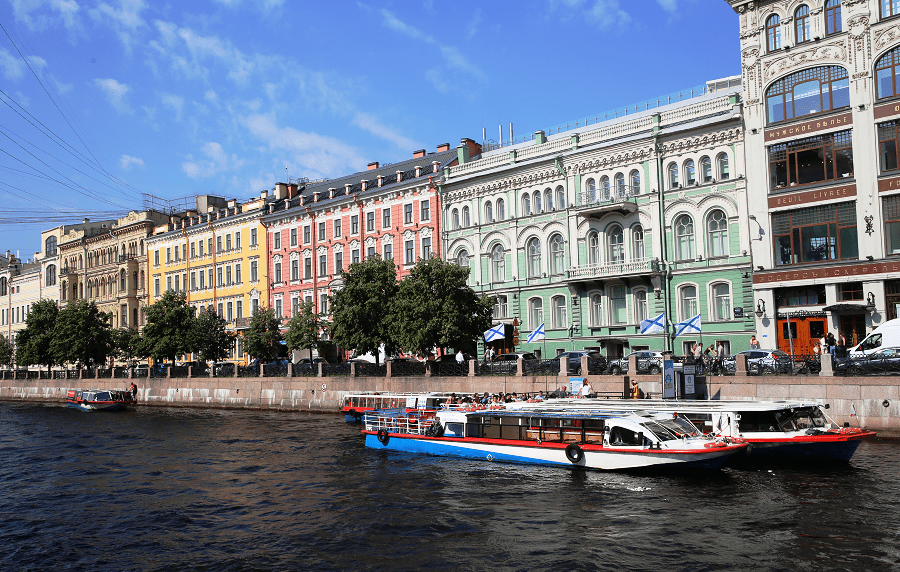The Moyka (also latinised as Moika) is a secondary, in comparison with the Neva, river in Saint Petersburg that encircles the central portion of the city.
It is the right branch of the Fontanka River flowing into the Bolshaya Neva, flowing out of it along the southern border of the Summer Garden and the Field of Mars.
Length – 4.67 km, width up to 40 m, maximum depth up to 3.2 m.
In 1736 the first Moyka quay was constructed in wood. Three bridges originally spanned the river: the Blue, the Green, and the Red. The 99-metre-wide Blue Bridge, now hardly visible underneath Saint Isaac’s Square, remains the widest bridge in the whole city.
Magnificent 18th-century edifices lining the Moyka quay include the Stroganov Palace, Razumovsky Palace, Yusupov Palace, New Holland Arch, Circular Market, St. Michael’s Castle, and the last accommodation and museum of Alexander Pushkin.
In 1798 work started to construct a stately embankment faced with red granite and adorned with ornate railings. After the completion of construction works in 1811, it was discovered that the water of the river became so muddy that its use for cooking has been officially forbidden ever since.
Main bridges
From source to mouth:
- 1st Engineering bridge
- 1st Sadovy Bridge
- 2nd Sadovy bridge
- Malo-Konyushenny bridge
- Big Konyushenny bridge
- Pevchesky bridge
- Green bridge
- Red bridge
- Blue bridge
- Lantern bridge
- Post Office bridge
- Kisses bridge
- Krasnoflotsky bridge
- Khrapovitsky bridge
- Ship bridge
Main attractions
The source of the Moyka River – Saint Michael’s Castle
Moyka, 3 – Building of the Round Market (1790s, architect Giacomo Quarenghi)
Moyka, 4 – the building of the Stable Department (the main facade overlooks Konyushennaya Square)
Moyka, 7 / Millionnaya street, 8 – profitable house of N. B. Glinka-Mavrin. Architect – A. K. Golosuev. Facade decoration – G.P. Khrzhonstovsky.
Moyka, 12 – the museum-apartment of A. S. Pushkin (the last apartment of the poet), since 1906 the apartment was occupied by the Department for the Protection of Public Safety and Tranquility.
Moyka, 14 – the house where Ivan Ivanovich Pushchin lived, now the Pushka Inn hotel is located here.
Moyka, 16 – the house in which the composer V. E. Basner lived. Mansion of the Zhadimirovskiys – the House of the Demidovs.
Moyka, 20 – Singing Chapel (architect L. N. Benois).
Moyka, 21 – the mansion of Prince S. S. Abamelek-Lazarev. Built in 1907-1909 according to the project of V. S. Vorotilov. Rebuilt in 1912 according to the project of I. A. Fomin.
Moyka, 22 – “Kempinski Hotel Moika 22”
Moyka, 24 – a mansion built in 1913, architect A. I. von Gauguin. An architectural monument of regional significance: from 1849 to 1917, the famous Donon restaurant was located in the courtyard of the building.
Moyka, 25 – A. I. Ebeling mansion, 1720s, 1803, architect Luigi Ruska. Director of the State Hermitage B. B. Piotrovsky lived in this house.
Moyka, 29 – Japanese Consulate.
Moyka, 30 – House of P. F. Skripitsyn (House of Korsakova), 1841, architect P. A. Dyutil.
Moyka, 31-33 – Profitable house of N. P. Ferzen, built in 1914-1915, neoclassical style, (architect P. M. Makarov). A. A. Sobchak lived in the house, a memorial plaque was installed.
Moyka, 32 – Printing house of the Ministry of Internal Affairs (Profitable house of A. A. Suvorin).
The building of the General Staff (architect K. I. Rossi).
Moyka, 35 – house of A. A. Arakcheev, 1797-1799, architect F. I. Demertsov. The outstanding scientist A. A. Fridman lived in this building with his father.
Moyka, 46 / Nevsky Prospekt, 17 – Stroganov Palace (architect F.-B. Rastrelli).
Moyka, 48 – the palace of K. G. Razumovsky (architects A. F. Kokorinov, J.-B. Vallin-Delamot). In 1797, the Petersburg Orphanage moved here from Millionnaya Street.
Moyka, 52 – also belonging to the Pedagogical University, the building of the former Petersburg Orphanage. Built at the beginning of the 19th century, purchased for the Orphanage in 1834. Rebuilt in 1839-1843 according to the project of the architect P. S. Plavov.
Moyka, 57 / Nevsky Prospekt, 18 – the house of the merchant K. B. Kotomin (architect V. P. Stasov). In the 1800s-1840s, Wolf and Beranger’s confectionery was located here.
Moyka, 58 – A. Jouen’s apartment building. Built in 1913-1914, architect R. F. Meltzer.
Moyka, 59 / Nevsky Prospekt, 15 – opposite the house of Kotomin, across Nevsky Prospekt was the house of Chicherin (cinema “Barricade”) – an architectural monument of federal significance.
Moyka, 60 – the former building of the hotel N. I. Sobolev “Russia”. Architect N. P. Basin, 1871-1872.
Moyka, 61 – St. Petersburg State University of Telecommunications named after Bonch-Bruevich.
Moyka, 62 / Grivtsova lane, 2 – Lipin’s apartment building is an architectural monument. Built in the 18th century (architect unknown), rebuilt in 1863 by E. K. Gernet.
Mariinsky Palace, St. Isaac’s Square.
Moyka, 64 / Grivtsova lane, 1 – tenement house of K. B. Corpus. 1879-1880. Architect A. R. Geshvend.
Moyka, 71 / Gorokhovaya street, 16 – profitable house of K. B. Corpus. 1876-1878. Existing house included. Architect A. R. Geshvend.
Moyka, 72 – the house of the Russian-American Company, later the building of a pawnshop (architect G. V. Baranovsky).
Moyka, 73 / Gorokhovaya street – the building of the trading house “Esders and Scheefhals building“. Built in 1906-1907 in the Art Nouveau style, the architects are V. A. Lipsky and K. N. de Rochefort.
At the corner of the Moyka and Bolshaya Morskaya there is the Palace of Culture of Communications Workers, formerly the building of the German Reformed Church (1862-1865) – architect G. E. Bosse; in 1872-1874 it was rebuilt by the architect K. K. Rakhau.
Moyka, 80-82 – two houses united by a single facade. In the courtyard of the house there are historical Voronin (Lantern) baths.
Moyka, 84 (per. Pirogova, 15) – the house of Kasatkin-Rostovsky, 1st quarter of the 19th century, 1837-1839, architect A. Kh. Pel, 1869-1870, architect N. L. Benois.
Moyka, 86-88 – the house of O. Montferrand (Y. V. Ratkov-Rozhnov), is an object of cultural heritage included in the unified state register of cultural heritage objects (monuments of history and culture) of the peoples of the Russian Federation with reg. No. 781510244380006.
Moyka, 90 – House of A. M. Golitsyn (I. G. Chernyshev, Count A. P. Shuvalov). Monument of strict (orderless) classicism. Built in 1790-1816. Architects: 1834 – arch. A. I. Bourgeois, 1842 – arch. A. M. Camuzzi, 1895 – arch. S. P. Kondratiev. At the beginning of the 20th century, the building was expanded.
Moyka, 94 – Yusupov Palace (J.-B. Vallin-Delamot, later – A. A. Mikhailov 2nd). Cultural heritage object 7810052000 In 1881, the architect A. D. Schilling built the Intercession Church at the palace (not preserved) .
Moyka, 96 – Until December 1917, the Alexander Military Law Academy was located in this building.
Moyka, 104 – apartment house, rebuilt in 1842-1849 according to the project of architect N.P. Grebenka, engineer-captain R.I. Truveller and architect R.B. Bernhard.
Moyka, 106 – the palace of the Grand Duchess Xenia Alexandrovna. The palace of Xenia Alexandrovna was built in 1857-1859 by I. A. Monighetti for M. V. Vorontsova.
Moyka, 108 – Demidov’s House of Charity of Workers, built on the basis of a building from the middle of the 18th century, was rebuilt several times.
Moyka, 112 and 114 / Pisareva street, 2 – tenement house and mansion of V. A. Schroeter (1897-1899).
The architectural ensemble of New Holland (the famous arch of New Holland overlooks the Moyka).
Moyka, 120 – Batashov’s estate, 1791.
Moyka, 122 – the palace of Grand Duke Alexei Alexandrovich (1882-1885, architect M.E. Messmacher). The building included the mansion of A. I. Saburov built in 1844 (architect D. E. Efimov).
Moyka, 124 / English Avenue, 1 – residential building of employees of the New Admiralty. A. I. Dmitriev, 1908-1909.
Moyka, 126 – Psychiatric hospital of St. Nicholas the Wonderworker from 1872, in the former building of the Correctional Institution and the Restraint House, built in 1840 (architect L. I. Charlemagne).




